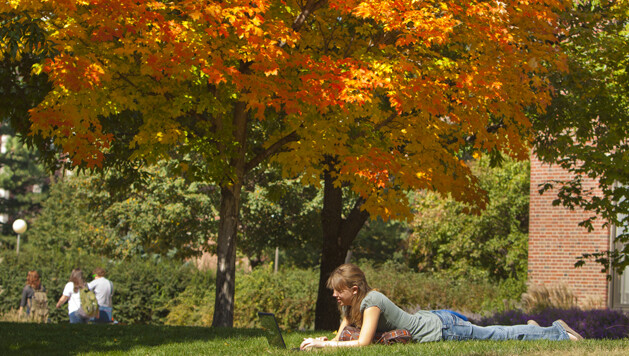
Fall is here and that means pumpkin spice lattes and changing leaves. But what actually causes leaves to change color?
UNL Extension forester Dennis Adams has the answer.
Contrary to popular belief, it’s not Jack Frost, but primarily shorter day length, Adams said.
This shorter day length causes chemical processes to take place in the leaf as the tree prepares for winter, Adams said. The type of pigments in the leaf as well as the weather both influence leaf color.
“No one knows for sure why seasonal behavior is more a response to light than to other environmental conditions,” Adams said. “Perhaps the reason is simply that most seasonal changes such as temperature or rainfall may vary from year to year, while the hours of daylight are not governed by climatic factors. Day length is the result of the regular movement of the earth around the sun and does not vary from year to year.”
The four types of pigments found in leaves are chlorophyll, carotene, xanthophyll, and anthocyanin. Chlorophyll provides the green color. Xanthophyll and carotene are the yellow and orange pigments, respectively.
“During the summer the green chlorophyll, which is associated with photosynthesis, dominates the other pigments and the leaves appear green,” Adams said. “Chlorophyll is constantly being broken down during the photosynthetic process, but it is also constantly being replaced in summer.”
When hours of daylight decrease in the fall, less chlorophyll is produced, but the breakdown of chlorophyll continues. The leaf sends nutrients to the body of the tree for storage and the leaf dies, leaving the yellow pigments behind.
Reds and purples occur when more food is produced in the leaf than can be readily transported to the tree for storage. “When this occurs, excess sugars may chemically react with other substances in the leaf to produce other pigments called anthocyanins,” Adams said. “Anthocyanins account for the reds and purples.”
Yellow fall leaf color is most common. Local trees and shrubs that exhibit a yellow color include cottonwood, ash, elm and hickory.
Red color is common in red maple and red oak.
Purple coloration is less common and is exhibited by white ash, gray dogwood and some viburnums.
Some trees such as the sugar maple contain all the pigments and may create a spectacular mixture of orange, red and yellow leaf colors.







